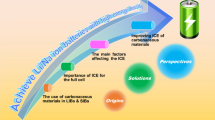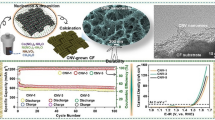Abstract
The design and preparation of non-noble metal catalysts with high catalytic activity and robust stability are important in the research of metal-air batteries and fuel cells. Here, a three-dimensional (3D) hierarchically ordered porous carbon nanomaterial was conveniently synthesized with zeolite-imidazole framework (ZIF-8) carbonization using the silica-template method and carbon nanotube (CNT) growth. The addition of an iron source endows the porous mFeNC-CNT with Fe-based nanoparticles and abundant atomically dispersive Fe-Nx sites from its nitrogen-incorporated graphitic carbon matrix. As a result, the 3D porous structure reduces the charge transport resistance, and the iron and nitrogen codoped carbon exhibits excellent catalytic activity for oxygen reduction reaction (ORR) similar to that of commercial Pt/C. Meanwhile, the interwoven CNTs obtained under urea catalysis further shorten the ion and electron diffusion pathway. Experimental and theoretical analyses revealed that the optimized mFeNC-CNT has a high ORR activity with a half-wave potential of 0.908 V and a large open-circuit voltage (1.556 V) when applied on zinc-air batteries. This work provides a promising strategy for the rational design and facile synthesis of high-performing non-noble metal-based electrocatalysts for energy storage, conversion, and transport applications.

摘要
设计和制备高催化活性和高稳定性的非贵金属催化剂对金属-空气电池和燃料电池研究具有重要意义. 本文中, 我们通过二氧化硅模板法和碳纳米管(CNT)生长对金属有机框架ZIF-8进行碳化, 合成了一种分级三维有序多孔碳纳米材料. 进一步通过添加铁源, 高温热解获得的多孔mFeNC-CNT具有精细的Fe基纳米颗粒以及原子分散Fe-Nx位点. 三维多孔结构降低了电荷传输阻力, 使得铁、 氮共掺杂碳表现出与商业Pt/C相当的氧还原反应(ORR)性能. 同时, 在尿素催化下得到的交织CNT在电化学过程中进一步缩短了离子和电子的扩散途径. 实验和理论计算结果表明, 优化后的mFeNC-CNT在锌空气电池上表现出较高的ORR活性. 综上, 这项工作为用于能量存储、 转换和传输应用的高性能非贵金属基电催化剂的合理设计和简便合成提供了一种有前景的策略.
Similar content being viewed by others
References
Dai L, Xue Y, Qu L, et al. Metal-free catalysts for oxygen reduction reaction. Chem Rev, 2015, 115: 4823–4892
Trogadas P, Coppens MO. Nature-inspired electrocatalysts and devices for energy conversion. Chem Soc Rev, 2020, 49: 3107–3141
Chen S, Qiu L, Cheng HM. Carbon-based fibers for advanced electrochemical energy storage devices. Chem Rev, 2020, 120: 2811–2878
Chong L, Wen J, Kubal J, et al. Ultralow-loading platinum-cobalt fuel cell catalysts derived from imidazolate frameworks. Science, 2018, 362: 1276–1281
Tan P, Chen B, Xu H, et al. Flexible Zn- and Li-air batteries: Recent advances, challenges, and future perspectives. Energy Environ Sci, 2017, 10: 2056–2080
Huang L, Zheng CY, Shen B, et al. High-index-facet metal-alloy nanoparticles as fuel cell electrocatalysts. Adv Mater, 2020, 32: 2002849
Pandey J, Hua B, Ng W, et al. Developing hierarchically porous MnOx/NC hybrid nanorods for oxygen reduction and evolution catalysis. Green Chem, 2017, 19: 2793–2797
Yan X, Jia Y, Yao X. Defects on carbons for electrocatalytic oxygen reduction. Chem Soc Rev, 2018, 47: 7628–7658
Li M, Zhao Z, Cheng T, et al. Ultrafine jagged platinum nanowires enable ultrahigh mass activity for the oxygen reduction reaction. Science, 2016, 354: 1414–1419
Zeng M, Liu Y, Zhao F, et al. Metallic cobalt nanoparticles encapsulated in nitrogen-enriched graphene shells: Its bifunctional electrocatalysis and application in zinc-air batteries. Adv Funct Mater, 2016, 26: 4397–4404
Wang MQ, Yang WH, Wang HH, et al. Pyrolyzed Fe-N-C composite as an efficient non-precious metal catalyst for oxygen reduction reaction in acidic medium. ACS Catal, 2014, 4: 3928–3936
Wang K, Chen H, Zhang X, et al. Iron oxide@graphitic carbon core-shell nanoparticles embedded in ordered mesoporous N-doped carbon matrix as an efficient cathode catalyst for PEMFC. Appl Catal B-Environ, 2020, 264: 118468
Zhu C, Shi Q, Xu BZ, et al. Hierarchically porous M-N-C (M = Co and Fe) single-atom electrocatalysts with robust MNx active moieties enable enhanced ORR performance. Adv Energy Mater, 2018, 8: 1801956
Ghosh S, Barg S, Jeong SM, et al. Heteroatom-doped and oxygen-functionalized nanocarbons for high-performance supercapacitors. Adv Energy Mater, 2020, 10: 2001239
Yang Y, Mao K, Gao S, et al. O-, N-atoms-coordinated Mn cofactors within a graphene framework as bioinspired oxygen reduction reaction electrocatalysts. Adv Mater, 2018, 30: 1801732
Sa YJ, Seo DJ, Woo J, et al. A general approach to preferential formation of active Fe-Nx sites in Fe-N/C electrocatalysts for efficient oxygen reduction reaction. J Am Chem Soc, 2016, 138: 15046–15056
Xia D, Yang X, Xie L, et al. Direct growth of carbon nanotubes doped with single atomic Fe-N4 active sites and neighboring graphitic nitrogen for efficient and stable oxygen reduction electrocatalysis. Adv Funct Mater, 2019, 29: 1906174
Liu J, Wan X, Liu S, et al. Hydrogen passivation of M-N-C (M = Fe, Co) catalysts for storage stability and ORR activity improvements. Adv Mater, 2021, 33: 2103600
Lai Q, Zheng L, Liang Y, et al. Metal-organic-framework-derived Fe-N/C electrocatalyst with five-coordinated Fe-Nx sites for advanced oxygen reduction in acid media. ACS Catal, 2017, 7: 1655–1663
Tang J, Yamauchi Y. MOF morphologies in control. Nat Chem, 2016, 8: 638–639
Zhong L, Ding J, Qian J, et al. Unconventional inorganic precursors determine the growth of metal-organic frameworks. Coord Chem Rev, 2021, 434: 213804
Mohideen MIH, Pillai RS, Adil K, et al. A fine-tuned MOF for gas and vapor separation: A multipurpose adsorbent for acid gas removal, dehydration, and BTX sieving. Chem, 2017, 3: 822–833
Wu MX, Yang YW. Metal-organic framework (MOF)-based drug/cargo delivery and cancer therapy. Adv Mater, 2017, 29: 1606134
Zhu L, Liu XQ, Jiang HL, et al. Metal-organic frameworks for heterogeneous basic catalysis. Chem Rev, 2017, 117: 8129–8176
Bavykina A, Kolobov N, Khan IS, et al. Metal-organic frameworks in heterogeneous catalysis: Recent progress, new trends, and future perspectives. Chem Rev, 2020, 120: 8468–8535
Tang WQ, Zhao YJ, Xu M, et al. Controlling the stacking modes of metal-organic framework nanosheets through host-guest noncovalent interactions. Angew Chem Int Ed, 2021, 60: 6920–6925
Mileo PGM, Adil K, Davis L, et al. Achieving superprotonic conduction with a 2D fluorinated metal-organic framework. J Am Chem Soc, 2018, 140: 13156–13160
Thorarinsdottir AE, Harris TD. Metal-organic framework magnets. Chem Rev, 2020, 120: 8716–8789
Ye Y, Cai F, Li H, et al. Surface functionalization of ZIF-8 with ammonium ferric citrate toward high exposure of Fe-N active sites for efficient oxygen and carbon dioxide electroreduction. Nano Energy, 2017, 38: 281–289
Zhang H, Hwang S, Wang M, et al. Single atomic iron catalysts for oxygen reduction in acidic media: Particle size control and thermal activation. J Am Chem Soc, 2017, 139: 14143–14149
Wang X, Dong A, Hu Y, et al. A review of recent work on using metal-organic frameworks to grow carbon nanotubes. Chem Commun, 2020, 56: 10809–10823
Huang Q, Guo Y, Chen D, et al. Rational construction of ultrafine noble metals onto carbon nanoribbons with efficient oxygen reduction in practical alkaline fuel cell. Chem Eng J, 2021, 424: 130336
Fang G, Zhou J, Liang C, et al. MOFs nanosheets derived porous metal oxide-coated three-dimensional substrates for lithium-ion battery applications. Nano Energy, 2016, 26: 57–65
Qiao M, Wang Y, Wang Q, et al. Hierarchically ordered porous carbon with atomically dispersed FeN4 for ultraefficient oxygen reduction reaction in proton-exchange membrane fuel cells. Angew Chem Int Ed, 2020, 59: 2688–2694
Lv X, Li X, Yang C, et al. Large-size, porous, ultrathin NiCoP nanosheets for efficient electro/photocatalytic water splitting. Adv Funct Mater, 2020, 30: 1910830
Al-Ghouti MA, Da’ana DA. Guidelines for the use and interpretation of adsorption isotherm models: A review. J Hazard Mater, 2020, 393: 122383
Zhao H, Liu L, Vellacheri R, et al. Recent advances in designing and fabricating self-supported nanoelectrodes for supercapacitors. Adv Sci, 2017, 4: 1700188
Liu S, Wang F, Dong R, et al. Soft-template construction of 3D macroporous polypyrrole scaffolds. Small, 2017, 13: 1604099
Xie J, Zhang H, Li S, et al. Defect-rich MoS2 ultrathin nanosheets with additional active edge sites for enhanced electrocatalytic hydrogen evolution. Adv Mater, 2013, 25: 5807–5813
Jayakumar A, Antony RP, Wang R, et al. MOF-derived hollow cage NixCo3−xO4 and their synergy with graphene for outstanding super-capacitors. Small, 2017, 13: 1603102
Chai L, Hu Z, Wang X, et al. Fe7C3 nanoparticles with in situ grown CNT on nitrogen doped hollow carbon cube with greatly enhanced conductivity and ORR performance for alkaline fuel cell. Carbon, 2021, 174: 531–539
Wang X, Chai L, Ding J, et al. Chemical and morphological transformation of MOF-derived bimetallic phosphide for efficient oxygen evolution. Nano Energy, 2019, 62: 745–753
Liu L, Zeng G, Chen J, et al. N-doped porous carbon nanosheets as pH-universal ORR electrocatalyst in various fuel cell devices. Nano Energy, 2018, 49: 393–402
Liu W, Chu L, Zhang C, et al. Hemin-assisted synthesis of peroxidase-like Fe-N-C nanozymes for detection of ascorbic acid-generating bioenzymes. Chem Eng J, 2021, 415: 128876
Qiu B, Fan S, Wang Y, et al. Catalytic membrane micro-reactor with nano ZIF-8 immobilized in membrane pores for enhanced Knoevenagel reaction of benzaldehyde and ethyl cyanoacetate. Chem Eng J, 2020, 400: 125910
Li P, Wang H, Fan W, et al. Salt assisted fabrication of lignin-derived Fe, N, P, S codoped porous carbon as trifunctional catalyst for Zn-air batteries and water-splitting devices. Chem Eng J, 2021, 421: 129704
Liang Y, Li Y, Wang H, et al. Co3O4 nanocrystals on graphene as a synergistic catalyst for oxygen reduction reaction. Nat Mater, 2011, 10: 780–786
Zhou T, Zhang N, Wu C, et al. Surface/interface nanoengineering for rechargeable Zn-air batteries. Energy Environ Sci, 2020, 13: 1132–1153
Zhu D, Zhao Q, Fan G, et al. Photoinduced oxygen reduction reaction boosts the output voltage of a zinc-air battery. Angew Chem Int Ed, 2019, 58: 12460–12464
Du D, Zhao S, Zhu Z, et al. Photo-excited oxygen reduction and oxygen evolution reactions enable a high-performance Zn-air battery. Angew Chem Int Ed, 2020, 59: 18140–18144
Lyu Z, Zhang XG, Wang Y, et al. Amplified interfacial effect in an atomically dispersed RuOx-on-Pd 2D inverse nanocatalyst for highperformance oxygen reduction. Angew Chem Int Ed, 2021, 60: 16093–16100
Acknowledgements
This work was financially supported by the Basic Science and Technology Research Project of Wenzhou, Zhejiang Province (G20190007 and ZG2017027), the BUCT-WZU Joint Fund (KH2012031), and the State Key Laboratory of Structural Chemistry, Chinese Academy of Sciences (20190008).
Author information
Authors and Affiliations
Contributions
Author contributions Qian J conceived the idea and supervised the project. Zhu K and Ji X contributed to the experiments. Chen D conducted the DFT calculations. The paper was primarily written by Qian J and Sun Q. All authors contributed to the general discussion.
Corresponding author
Ethics declarations
Conflict of interest The authors declare that they have no conflict of interest.
Additional information
Supplementary information Supporting data are available in the online version of the paper.
Qiuhong Sun received her bachelor’s degree from Wenzhou University in 2020, and now she is a graduate student at Wenzhou University. Her current research focuses on the design and synthesis of MOF-derived hierarchically porous materials using silica templates for electrochemical applications.
Jinjie Qian is an associate professor at the College of Chemistry and Materials Engineering, Wenzhou University. He received his PhD degree from Fujian Institute of Research on the Structure of Matter, Chinese Academy of Sciences (CAS), under the supervision of CAS Academician Maochun Hong. His current research focuses on the electrochemical research on carbon nanomaterials from metal-organic frameworks for energy storage and conversion.
Rights and permissions
About this article
Cite this article
Sun, Q., Zhu, K., Ji, X. et al. MOF-derived three-dimensional ordered porous carbon nanomaterial for efficient alkaline zinc-air batteries. Sci. China Mater. 65, 1453–1462 (2022). https://doi.org/10.1007/s40843-021-1933-4
Received:
Accepted:
Published:
Issue Date:
DOI: https://doi.org/10.1007/s40843-021-1933-4




